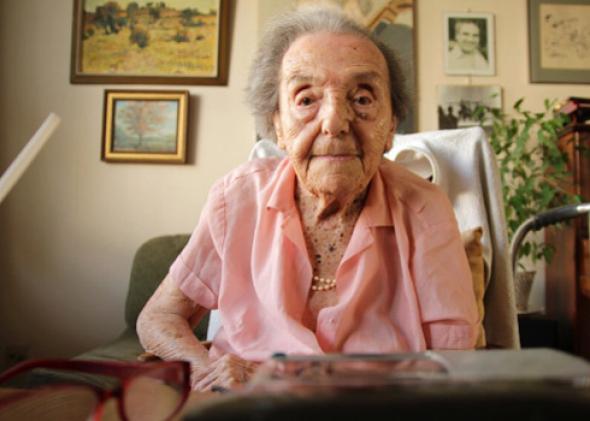When Malcolm Clarke’s The Lady in Number 6 wins the Oscar for Best Documentary Short Subject on Sunday night, as it almost certainly will, there will no doubt be—among those few who bother to remark on the results in such an unglamorous category—a round of jokes about the converging factors that made its victory inevitable. This 38-minute-long film is a portrait of the world’s oldest Holocaust survivor, Alice Herz-Sommer, a classical pianist who played in the orchestra of the Potemkin-village concentration camp Theresienstadt. After settling in London, Herz-Sommer continued to practice the piano for hours each day until near the end of her life—which came Sunday at age 110, two days before the close of Oscar voting. Between the Academy’s longstanding preference for Holocaust stories and its penchant for handing out posthumous awards, The Lady in Number 6 is pretty much a lock.
But please don’t let the wisecracks about Academy predictability and cliché keep you from watching The Lady in Number 6 (available for rental or purchase here), which is neither predictable nor clichéd nor—get this—even remotely depressing. Rather, this talking-head interview with a woman who lived through the worst the 20th century had to offer—and outlived every member of her family, including, eventually, the treasured son who was her only relative to make it through the war—is a document of pure joy and an encounter with a person you will count yourself lucky to have met, even briefly and indirectly, once in your lifetime.
Alice Herz was born in Prague in 1903 into a cultured Jewish family—her mother was a friend of Franz Kafka and Gustav Mahler, and she recalls in the film how she and her twin sister would take walks with Kafka while he made up stories for them. (Stories “which I’ve forgot,” she tells the off-screen interviewer in the film, “but I remember the atmosphere. It made a deep impression.” One can imagine.) She became a successful concert pianist in the 1930s and married her true love, businessman and amateur violinist Leopold Sommer, whom she relates a few anecdotes about with the proud passion of a young bride. They had a son, Stephan, and were just entering a halcyon period of their lives when the war pulled their family apart. A year after losing her widowed mother to deportation, Alice was sent with her husband and son to Theresienstadt. Leopold would later be transported to Auschwitz and then Dachau, where he died in 1945. But Alice and her son would be allowed to wait out the war in the Nazis’ ghoulish “model” concentration camp because of the music-loving German officers’ admiration for her playing.
The part of the film that deals with Alice’s experience at the camp is relatively short, and blessedly free of the stock newsreel footage of starved bodies that seems to appear in every documentary of the time and that threatens to turn our collective memory of the Holocaust into a History Channel montage. There is, though, one wrenching shot of the Theresienstadt children’s choir singing onstage. The camera moves along the row of tense, miserable faces (some of them incongruously made up as clowns) pausing on the face of one thin, jug-eared boy at the end of a row. It’s Alice’s son Stephan, who would take the name Raphael Sommer when he went on to become a concert cellist after the war, eventually dying of an aneurysm at 64—a lifespan that, as his century-plus-old mother points out, no longer really counts as reaching old age.
I’m not making much of a case here for The Lady in Number 6’s status as a nondepressing Holocaust documentary, am I? But maybe that’s because the case can really only be made by Alice Herz-Sommer herself. This is less a film about one woman’s awful experiences in wartime than about the remarkable person she became afterward, in large part thanks to a lifelong belief in and dedication to the power of music to transfigure and redeem human suffering. “It is a mystery,” she says in her still-heavy accent, pausing to choose each word carefully, “that when the first tone of music starts, it goes straight in our soul. … Music is God.” And throughout the documentary, she proves this claim with her fingers, sitting down at the keyboard to play Bach, Beethoven, Schumann, and her wartime favorite, Chopin, with exquisite expressiveness and control.
The director also spends time interviewing two of Alice’s close friends, who are camp survivors, one of whom first met her in Theresienstadt. All three women evince an extraordinary optimism and strength of character, but even among their company, Alice is something special. The word “saint” sounds overly sanctimonious (not to mention profoundly un-Jewish), but there’s something holy about this woman’s utter openness to the moment, her deep commitment to her art, and her tangible happiness and gratitude for every minute of extra life she’s been vouchsafed. “Sometimes it happens that I am thankful to have been there,” she says of her time at the camp, “because this gave me a … I am richer than other people. When I hear them saying, oh, this is terrible—no, it is not so terrible.”
Early on in the film, Alice relates a memory of her son at the age of three, sitting in their Prague apartment before the war as she listens to classical music on the gramophone. As the piece reaches what she describes as an “enormous fortissimo,” the boy begins to cry and she asks him what’s the matter. “I’m crying because the music is so beautiful,” he replies. At that moment in the story, Alice grows quiet, giving her interviewer a smile and shrug that seem to say, well, there you go—what else could we possibly have been put here on earth to know? You will leave The Lady in Number 6 weeping for the exact same reason as that overwhelmed, happy little boy. Please forget all about the Oscars, and just see it.
